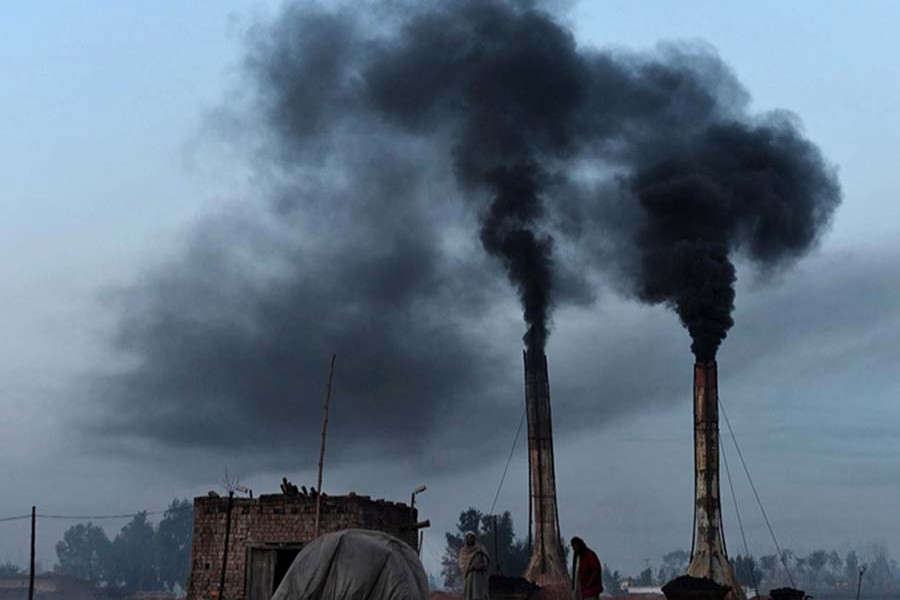
Published :
Updated :

Just a week has gone by after the conclusion of the fortnight-long COP26 conference on global climate. There have been few pledges and work-plans on emission cut and climate funds before for the vulnerable countries. But many climate-saving heavyweights and activists in general have dubbed the summit-cum-conference a near-fiasco. As the curtain fell on the mega event, replete with promises, an uncanny gloom pervaded the departing participants. Against this backdrop, Bangladesh has begun feeling the slow arrival of its dry winter.
The otherwise pleasant season of winter, hitting the country's northern region hard in some years, portends also fraught times for vast stretches in villages and the city suburbs. Like in every year, a scourge comes in the form of brick fields that release smokes from their kilns. Environmentalists have found that certain types of these kilns directly aggravate the carbon emission, and contribute to global warming. According to environmentalists, there are various types of brick kilns now in operation in Bangladesh. They are Bull's Trench Kiln, Fixed Chimney Kiln, Zigzag Kiln and Hoffman Kiln. The owners of these kilns have been singled out for their recklessness in polluting the atmosphere of vast areas in the country.
With the seasons of rain gone, and the long phase of the dry seasons of winter and summer in place, the brick kiln owners have resumed their annual operation. It happens every year. The activities of these polluters this year could have been delayed or held up as a gesture of respect to the global climate summit in Glasgow. These thoughts, in the context of Bangladesh or any other country dominated by environmentally hostile elements, finally turn out to be wishful. Knowing full well their futility, many an optimist keeps these dreams at bay.
The polluters care the least about the grim prospects which might be awaiting Bangladesh. Their attitude is like saying --- "Come what may, we can't stop operating our brick kilns even if their operation hastens global warming." They will point out their livelihood which, finally, might become a sticking point. But the whole situation can be brought into the favour of the people worried about the future climate assaults. It's the government's relevant authorities on whom lie the onusof telling the factory units about the environment-friendly or green bricks. Few of the factory owners know about the cost-effectiveness of making these bricks, and fewer still about their wide use abroad.
There are about fifty thousand traditional brick factories in the country. They continue to emit carbon and other gases since the very start of their operation. According to a study, the region of Chattogram emits the largest volume of carbon in Bangladesh. Over the last two decades, the emission rate reached 93 per cent of the whole country. The Sylhet area has been found to be the lowest carbon emitting, only 17 per cent in the last two decades.
Prime Minister Sheikh Hasina told the COP26 colloquium that her country would slap an effective restraint on the use of coal. She was among the leaders of 40 countries at the climate conference which had committed to shift away from coal as a fuel. After the large coal-using countries such as China, India, USA and Germany, the major coal-dependent countries include Poland, Vietnam and Chile. Bangladesh is far behind all these countries when it comes to using coal as an industrial fuel. It might take some more time for the fledgling industrialising country to completely extricate itself from the carbon emitting fuel. For the present, Bangladesh has concentrated on producing nuclear energy.
Environmentalists have termed the energy 100 per cent carbon-free and environment-friendly. Due to the country being dependent on agriculture in the main, it has never felt the need for producing and importing coal. However, acute fuel shortage has prompted it to turn to natural gas and petroleum. The country has a comfortable reserve of natural gas; but its waste and overuse has often led to the production and use of coal.
Now that the government has committed to cutting down on its coal dependence, use of the harmful fossil fuel is expected to be phased out eventually. By that time its maiden nuclear energy plant could start operating. This chapter is set to discover a Bangladesh running its industrial activities with nuclear energy. The tale is not that plain and linear. Elements are there to foil the ambitious goals of the government. The quarters manufacturing coal are feared to remain stuck to their age-old production methods. Ruefully, most of them are ignorant about the phenomena of climate, climate changes and, finally, global warming --- let alone the Prime Minister's commitment to putting a lid on the releaseof fossil fuel like coal in the near future. The brick field or brick kiln owners are not alone in the dirty episode. The authorities dealing with environmental protection are tasked with monitoring the operations of these factories across the country. The extent to which the brick fields are mushrooming, many on the fringes of croplands and human settlements and trade centres, the logic behind their assignments to monitor these brick manufacturers continues to remain illusory.
Upon being assigned the task of supervising the trend which the factories should follow through abiding by mandatory rules, it's them who are, finally, responsible for ensuring that the country remains free of coal-based carbon emission. Ironically, the coals which are used in the brick kilns come from trees being felled illegally.
shihabskr@ymail.com


 For all latest news, follow The Financial Express Google News channel.
For all latest news, follow The Financial Express Google News channel.